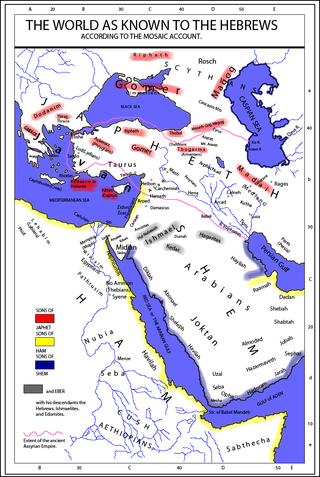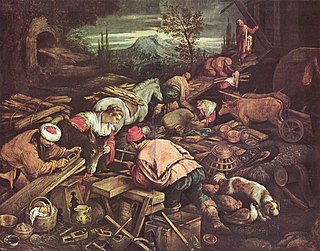
Japheth is one of the three sons of Noah in the Book of Genesis, in which he plays a role in the story of Noah's drunkenness and the curse of Ham, and subsequently in the Table of Nations as the ancestor of the peoples of the Aegean Sea, Anatolia, Caucasus, Greece, and elsewhere in Eurasia. In medieval and early modern European tradition he was considered to be the progenitor of the European peoples.

Noah appears as the last of the Antediluvian patriarchs in the traditions of Abrahamic religions. His story appears in the Hebrew Bible, the Quran and Baha'i writings, and extracanonically.

The Generations of Noah, also called the Table of Nations or Origines Gentium, is a genealogy of the sons of Noah, according to the Hebrew Bible, and their dispersion into many lands after the Flood, focusing on the major known societies. The term 'nations' to describe the descendants is a standard English translation of the Hebrew word "goyim", following the c. 400 CE Latin Vulgate's "nationes", and does not have the same political connotations that the word entails today.

Sefer haYashar is a medieval Hebrew midrash, also known as the Toledot Adam and Divrei haYamim heArukh. The Hebrew title "Sefer haYashar" might be translated as the "Book of Righteousness". but it is known in English translation mostly as The Book of Jasher following English tradition. Its author is unknown.

Lud was a son of Shem and grandson of Noah, according to Genesis 10.
Tubal, in Genesis 10, was the name of a son of Japheth, son of Noah. Modern scholarship has identified him with Tabal. Traditionally, he is considered to be the father of the Caucasian Iberians according to primary sources. Later, Saint Jerome refashioned the Caucasian Iberia (Georgia) into the Iberian Peninsula and Isidore of Seville consolidated this idea.

Madai is a son of Japheth and one of the 16 grandsons of Noah in the Book of Genesis of the Hebrew Bible.

Ham, according to the Table of Nations in the Book of Genesis, was the second son of Noah and the father of Cush, Mizraim, Phut and Canaan.

In the Bible, Meshech or Mosoch is named as a son of Japheth in Genesis 10:2 and 1 Chronicles 1:5.

Togarmah is a figure in the "table of nations" in Genesis 10, the list of descendants of Noah that represents the peoples known to the ancient Hebrews. Togarmah is among the descendants of Japheth and is thought to represent some people located in Anatolia. Medieval sources claimed that Togarmah was the legendary ancestor of several peoples of the Caucasus.
Tiras is, according to the Book of Genesis and 1 Chronicles, the seventh and youngest son of Japheth in the Hebrew Bible. A brother of biblical Javan, its geographical locale is sometimes associated by scholars with the Tershi or Tirsa, one of the groups which made up the Sea Peoples "thyrsenes" (Tyrrhenians), a naval confederacy which terrorized Egypt and other Mediterranean nations around 1200 BCE. These Sea People are referred to as "Tursha" in an inscription of Ramesses III, and as "Teresh of the Sea" on the Merneptah Stele.
Gomer was the eldest son of Japheth, and father of Ashkenaz, Riphath, and Togarmah, according to the "Table of Nations" in the Hebrew Bible.
Elishah or Eliseus was the son of Javan according to the Book of Genesis (10:4) in the Masoretic Text. The Greek Septuagint of Genesis 10 lists Elisa not only as the son of Javan, but also a grandson of Japheth. His name is spelled differently in Hebrew to the prophet Elisha, ending in a hei instead of an ayin.

In the Book of Genesis, the curse of Ham is described as a curse which was imposed upon Ham's son Canaan by the patriarch Noah. It occurs in the context of Noah's drunkenness and it is provoked by a shameful act that was perpetrated by Noah's son Ham, who "saw the nakedness of his father". The exact nature of Ham's transgression and the reason Noah cursed Canaan when Ham had sinned have been debated for over 2,000 years.

The wives aboard Noah's Ark were part of the family that survived the Deluge in the biblical Genesis flood narrative from the Bible. These wives are the wife of Noah, and the wives of each of his three sons. Although the Bible only notes the existence of these women, there are extra-biblical mentions regarding them and their names.

Ashkenaz in the Hebrew Bible is one of the descendants of Noah. Ashkenaz is the first son of Gomer, and a Japhetic patriarch in the Table of Nations. In rabbinic literature, the descendants of Ashkenaz were first associated with the Scythian cultures, then later with the Slavic territories, and, from the 11th century onwards, with Germany and northern Europe, or the Indo-European people, in a manner similar to Tzarfat or Sefarad.

Canaan, according to the Book of Genesis in the Hebrew Bible, was a son of Ham and grandson of Noah, as well as the father of the Canaanites.

Naamah is mentioned in the Bible, in Genesis 4:22, as a descendant of Cain. She was the only mentioned daughter of Lamech and Zillah and their youngest mentioned child; her brother was Tubal-cain, while Jabal and Jubal were her half-brothers, sons of Lamech's other wife Adah. She is often conflated with or connected to Naamah of the Zohar, one of the first women to seduce the grigori and give birth to nephilim.

Baath or Baath mac Magog is a figure in Irish legendary history. He was a son of Magog, son of Japheth, the progenitor of the Scythians, son of Noah, and the father of Fénius Farsaid, according to a version "M" of Lebor Gabála Érenn, also known as the Great Book of Lecan. He is described as being from Scythia, and the Goths, or the Gaedil. According to the same version of the story, he had four brothers, Ibath, Barachan, Emoth, and Aithechta. But the story further states that "...Feinius Farrsaid was son of Baath, son of Ibath, son of Gomer, and son of Iafeth".

Since early modern times, a number of biblical ethnonyms from the Table of Nations in Genesis 10 have been used as a basis for classifying human racial and national identities. The connection between Genesis 10 and contemporary ethnic groups began during classical antiquity, when authors such as Josephus, Hippolytus and Jerome analyzed the biblical list.















